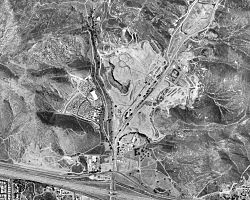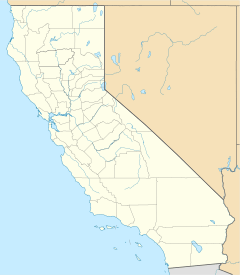Stringfellow Acid Pits facts for kids
Quick facts for kids Stringfellow Acid Pits |
|
|---|---|
| Superfund site | |

USGS satellite photo of the Stringfellow Acid Pits located north of California State Route 60.
|
|
| Geography | |
| City | Jurupa Valley, California |
| County | Riverside |
| State | California |
| Coordinates | 34°01′24″N 117°27′39″W / 34.0234°N 117.4607°W |
| Information | |
| CERCLIS ID | CAT080012826 |
| Contaminants | VOCs, Heavy metals, Perchlorate, Pesticide, PCBs, Sulfates |
| Responsible parties |
California Department of Toxic Substances Control |
| Progress | |
| Proposed | 12/30/1982 |
| Listed | 09/08/1983 |
| List of Superfund sites | |
The Stringfellow Acid Pits are a place where harmful industrial waste was stored. It is located in Jurupa Valley, California, in the United States. This site is also known as a Superfund site. A Superfund site is a place that has been badly polluted and needs a special cleanup.
In the early 1980s, the Stringfellow Acid Pits became famous across the country. It was known as one of the most polluted places in California. There were also problems and scandals linked to the U.S. Environmental Protection Agency (EPA) because of this site.
Contents
History of the Stringfellow Site
The Stringfellow Acid Pits site is about 17 acres big. It is located at the base of the Jurupa Mountains in Pyrite Canyon. The land was first a rock quarry, which is a place where rocks are dug out of the ground. James Stringfellow owned this quarry.
In 1956, James Stringfellow opened the site for dumping industrial waste. This happened after talks with the Santa Ana Regional Water Quality Control Board. Geologists had said the site was safe for waste because of its solid bedrock. They thought the valley was a perfect place to store harmful liquids.
However, by 1972, it became clear that the pits were leaking. The harmful liquids were getting into the local groundwater. Groundwater is the water found underground in cracks and spaces in soil, sand, and rock. Because of the leaks, the Water Quality Control Board closed the site.
Over 16 years, more than 34 million gallons of liquid industrial waste were put into ponds at the site. Between 1969 and 1980, bad weather and poor management caused more problems. Harmful chemicals spilled or were released into Pyrite Creek. This creek flowed into storm channels that went through the nearby town of Glen Avon.
Becoming a Superfund Cleanup Site
In the early 1980s, a new law was passed called the Comprehensive Environmental Response, Compensation and Liability Act. This law created the Superfund program. The Stringfellow Acid Pits quickly became a focus for the US Environmental Protection Agency. It was listed as the most polluted site in California. It was also one of the first places chosen for cleanup under the new Superfund law.
The serious problems at the site, and a scandal that followed, made the acid pits a topic on national television. A local activist named Penny Newman worked hard to get the site listed as a Superfund site.
Today, the California Department of Toxic Substances Control (DTSC) manages the Stringfellow Site. Experts believe the cleanup effort will take about 500 years to complete.
Controversy and Leadership Changes
In 1982, Rita Lavelle was chosen to lead the Superfund program. She faced serious problems related to how Superfund money was used. These problems also involved issues at the Stringfellow Acid Pits. Because of this controversy, she was removed from her position.
Anne Gorsuch Burford, who was the head of the EPA at the time, also resigned because of the problems.
Legal Battles Over the Site
The Stringfellow site led to many lawsuits. These included cases in federal courts and local courts. One important case was Hendler v. United States. The U.S. Supreme Court also made a decision about one part of the case in 1987.
Lawsuits about insurance for the site continued for many years, even into the 21st century. Overall, the legal battles related to the Stringfellow site lasted for more than 30 years.
Images for kids



